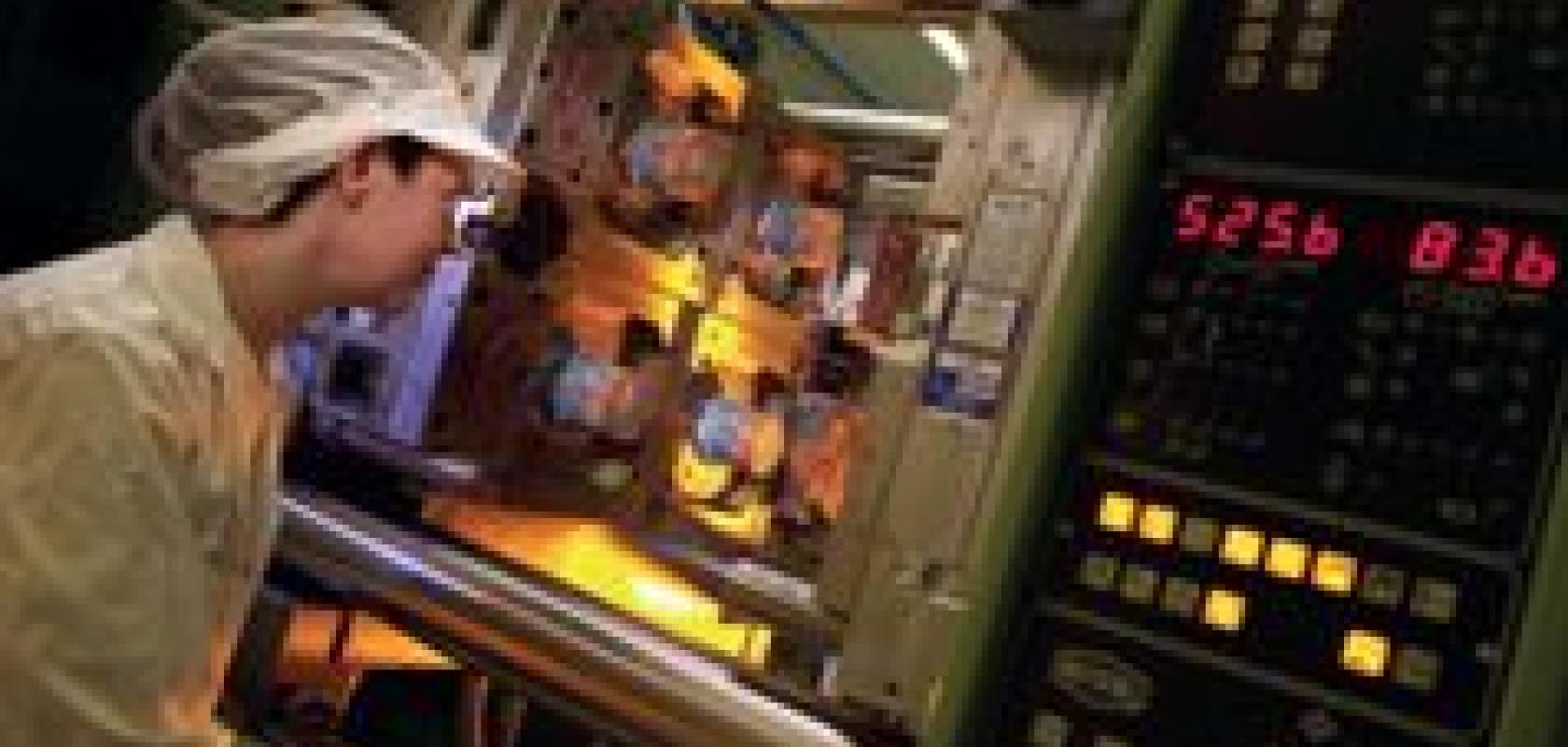Machine vision and packaging tend to go hand in hand. Packaging lines are highly automated and usually high-speed and high-volume, all of which lends itself to machine vision. Inspection tasks range from checking fill levels in bottles to making sure labels match the product and are positioned correctly.
‘The most common use of vision on packaging lines is reading the date codes on the side of boxes,’ comments Chris Pitt at European vision provider, Stemmer Imaging. All medical and food packaging has to have a use-by and best-before date. ‘If a sandwich doesn’t have a best-before date,’ Pitt continues, ‘and someone reports it to Tesco, Tesco charges the supplier a fine of up to £50,000 and the supplier is responsible for removing all the faulty products from the shelves and restocking them. So it’s a really easy vision sale that works extremely well to verify date codes, not only that they are present, but that they read correctly as well.’
A vision system will scrutinise date codes and other information on labels on food packaging. The label also has to match the food in the packaging – the wrong sleeve on a ready-meal, for example, is not only misleading but potentially dangerous, as the sleeve will display incorrect allergy advice for the food inside.
RPC Superfos, with headquarters in Taastrup, Denmark, has installed vision systems at its Randers, Denmark production lines. The factory manufactures injection-moulded plastic packaging, mainly lids and pots for food products. The inspection system, incorporating 53 digital FireWire cameras from Allied Vision Technologies (AVT), was installed by TriVision, a Danish machine vision solution provider.
The vision system was installed at the Randers factory on high volume packaging lines producing around 250 million lids and pots a year. ‘At those volumes it’s not possible to carry out quality checks manually,’ comments Stig Skovbo Sørensen, a project engineer at RPC Superfos. The lids and pots are also considered high-end packaging and the customer has high expectations for product quality.
The packaging lines are completely automated – the products are made and packed in cardboard boxes robotically – so there’s no possibility for quality control without machine vision.
‘We used to have a workforce manually inspecting the products when we were manufacturing on two- and four-cavity moulds,’ says Sørensen, i.e. only two or four pieces respectively came out of the machines every cycle. ‘Now, we’re producing on 4 x 4, 6 x 6 and even 8 x 8 cavity moulds with a cycle time around five seconds, so it’s a huge amount of products.’
The packaging lines generate square and round plastic containers and lids for foods like butter and cheese. For inspecting square butter boxes, for instance, two Stingray F-046B cameras from AVT are positioned below a conveyor belt and inspect the inside surface of the box as it passes above them. Simultaneously, an AVT Stingray F-201B inspects the printed artwork from above to check the correct position of the label and barcode. The lids used to seal the containers are controlled on separate lines using Stingray F-201C colour cameras. The Stingray camera combines a fast IEEE 1394b interface with advanced image optimisation functions (AVT smart features).
‘When you think about vision, you think it must be quite simple to take a picture and compare it to another picture. This is not the case,’ Sørensen says. ‘The vision system sees everything, which means you need to specify what you want to inspect and the tolerances constituting a pass and a fail. And there are multiple variables to consider – colour, label placement, what comprises contamination in the plastic resin, plastic thickness, etc; it’s a huge amount of information you have to process and make a decision on. We found out very quickly that it was easy to design the vision system to remove a lot of products with minor failures, but the biggest hurdle was to keep acceptable products out of the waste basket. A lot of the products that failed the inspection were actually good enough and we had to refine the parameters many times to get the desired level of acceptance.’
By installing the vision system, RPC Superfos wanted to ensure 100 per cent control of the manufacturing process. ‘It would be difficult to identify the specific cause of a failure on the high volume moulds without the vision system,’ continues Sørensen. ‘The vision system employs a lot of statistical analysis for each cavity on the types of failure, so that the operator can determine very quickly the potential origin of the defect and can correct it.’

High-speed packaging lines make machine vision essential for quality control. Image courtesy of Microscan
Sørensen comments that the disadvantage with relying on the vision system is that it’s the only means of quality control, so that if it isn’t working on one of the lines, that line won’t run. ‘We have promised our customers that there will be 2.5 per cent or less defective items,’ he says. The advantage, however, is that the engineers are forced to investigate and do something about the cause of all defective products. ‘Even the smallest part defect will be looked into as to the reason why it failed,’ Sørensen adds.
Keeping food fresh
Often in packaging, different components of the container will be made in different factories and then transported to a different site for filling and sealing. Olmec, based in Barton-upon-Humber in the UK, has designed an inspection system for identifying defects in foil-lined lids for jars of powdered drink. The plastic cap is manufactured with a foil insert that gets sealed onto the jar. Because the lids are mass produced elsewhere and then transported to the factory where the jars are filled and capped, there is a risk that the foil becomes dented and delaminated during transit. If the foil is damaged it doesn’t seal and the product integrity can’t be guaranteed.
‘Because of the nature of the defect, there wasn’t one illumination setup that suited every check,’ explains Robert Pounder, technical director at Olmec. ‘The foil is reflective so direct illumination will identify some of the defects, but not all – foil lifts or slight bubbling in the material are impossible to see with direct illumination. These defects are revealed with incident or low angle lighting from one side.’
Olmec created a ring-illuminated setup with three cameras. As the lids passed, each was illuminated in three different structured events so that the cameras acquired nine images between them in 45ms. The lid was illuminated fully, which exposed half the defects, and also illuminated from two separate sides so that dents would show as dark pixels while foil lifts would reflect the light and be seen as saturated pixels.
‘The line runs at 140 parts per minute, but because of the way the products are handled it meant we had to cope with speeds of up to 500 parts per minute,’ notes Pounder. The machine had a buffering mechanism that would fill very quickly once emptied. It wasn’t the case that every time a cap was taken out a cap was put in; 10 caps would be removed and then 20 would fill the buffer. This meant the vision system would be dormant for three seconds and then would see a burst of product fly through.

Pharmaceutical glass vials are checked for any contamination present in the freeze-dried product, as well as damage to the vial or flip-off seal. Image courtesy of Cognex
‘When we got up to those high speeds, it became a case of needing to analyse the image effectively in the first place, with no second checks to confirm the decision,’ Pounder continues. The system images at 15ms intervals – three images followed by another three images 15ms later. The problem, Pounder explains, was that in the 15ms the product could rotate slightly. Originally, as the velocity of the conveyor was fixed (70m/min), Olmec wanted to designate the first image as the master and all the coordinates set and translated to the subsequent images. But if the part was rotating in a random fashion, the engineers had to introduce a search into every image window. The biggest concern, according to Pounder, was therefore how to optimise that search so the system didn’t run over time.
Blister packs
Line scan cameras are employed for high-speed inspection or when inspecting parts like blister packs. ‘Blister packs are an example of a product where, even if the application isn’t particularly high speed, there is a lot of information to get out of the image,’ states Jonathan Ludlow, product manager at Microscan.
‘In pharmaceutical packaging, the fault that companies worry about most is having the wrong product in the package or a package wrongly labelled,’ Ludlow continues. Microscan provides some pre-configured vision systems for inspection of pharmaceuticals. In this market there are specific requirements in terms of levels of access protection. The FDA has a requirement that date and lot codes should be verified for legibility and content, a task typically carried out by a vision system.
Systems also have to comply with 21 CFR Part 11, an FDA regulation concerned with creating audit trails for changes made in software programs. Microscan has a version of its software that’s pre-configured to support this. The company is also launching a new version of its I-PAK vision system (I-PAK SE2), which includes a stainless steel enclosure complying with typical pharma and food and beverage manufacturing requirements.
Pitt at Stemmer Imaging notes that laser profiling is an extremely good way of inspecting medical blister packs. ‘By building up a 3D height map, you can tell whether pills are in place or not,’ he says. The technique also allows you to check the volume of powder in the pills. GoCator from LMI is a 3D camera that can be used for this.
Pharma glass vials
Pharmaceuticals production is subject to stringent quality control and vision is often employed throughout. Eisai Machinery, located in Cologne, Germany, has developed the AIM 596 for inspection of pharmaceutical glass vials. The machine uses Cognex In-Sight vision systems and can check up to 12,000 packages per hour in its fastest version.
The system is designed, firstly, to determine the cake height of the freeze-dried contents of the vial and detect the presence of any foreign objects. At the same time, it looks for ‘splashings’ or splatters caused by unwanted boiling during the freeze-drying process. A standard industrial camera then looks for foreign particles on the outside of the cake and cracks, scratches, or air pockets in the glass. The undersides of vials, as well as the vial cap and the flip-off seal are also inspected. The presence of components, the colour of the cover and, for aluminium caps, the correct processing of the crimp, are all checked.
Defective products are sorted into various trays, depending on the nature of the defect. Products that pass the testing process are forwarded to a labelling or packaging machine. Only the glass vials with 100 per cent product quality enter the pharmaceutical wholesale chain and are distributed to clinics, pharmacies, and medical practices. This highly automated production line can only achieve the level of quality control needed for packaging pharmaceuticals through the use of machine vision.


